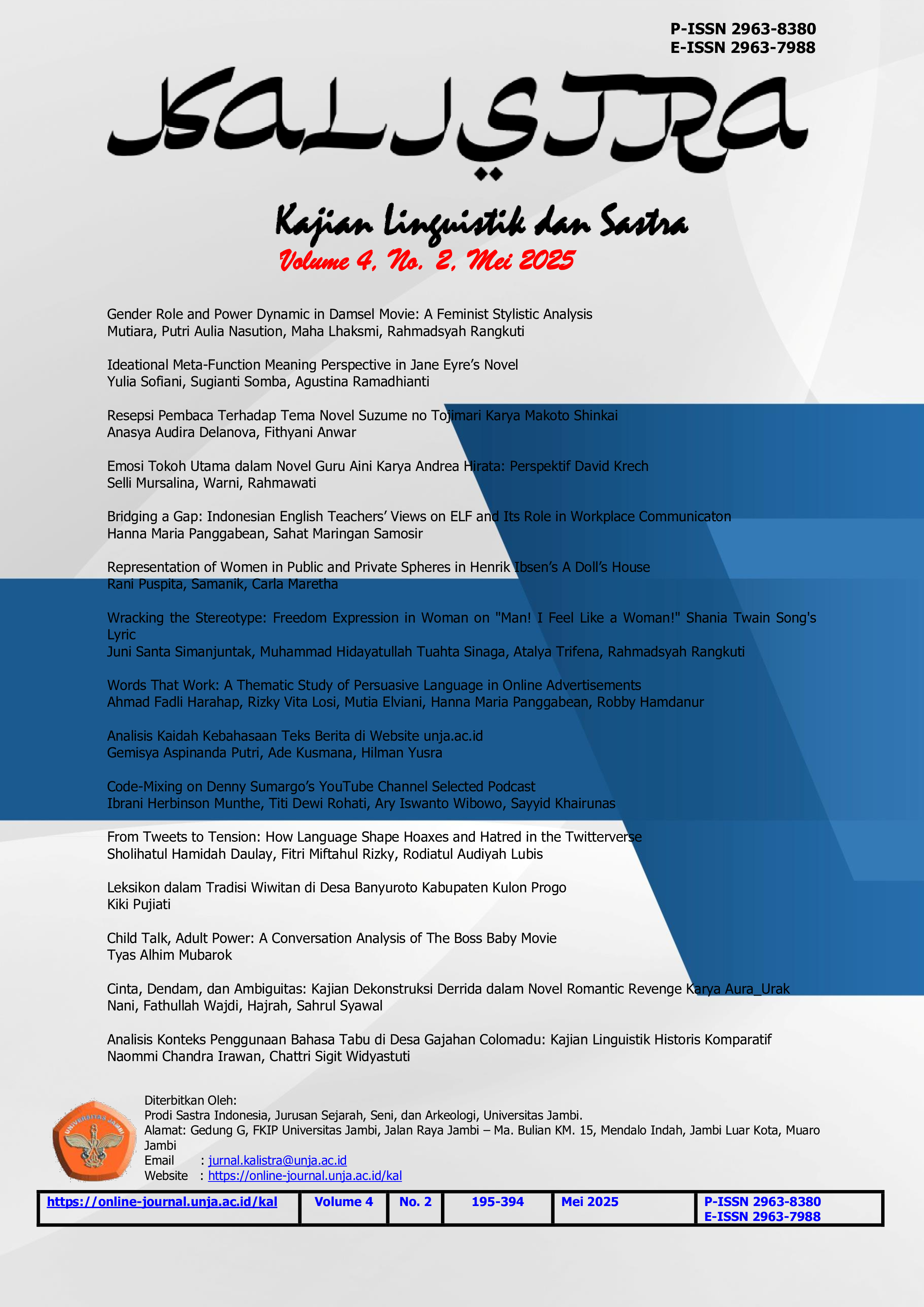Emosi Tokoh Utama dalam Novel Guru Aini Karya Andrea Hirata: Perspektif David Krech
DOI:
https://doi.org/10.22437/kalistra.v4i2.43086Keywords:
emosi, tokoh utama, novelAbstract
This research aims to analyze the emotions of the main character in the novel Guru Aini by Andrea Hirata. The method used in this research is descriptive qualitative method. This research uses a literary psychology approach and uses David Krech's emotion classification theory. The data collection technique uses reading and note-taking techniques. The data analysis technique used consists of four stages, namely data collection, data reduction, data presentation, and conclusion drawing. The data collected in this study are in the form of quotations related to the emotions of the main character in the novel Guru Aini by Andrea Hirata. Based on the results of the study, 24 data were found that included the emotions of the main character in the novel Guru Aini. The emotions found are joy 3, anger 5, fear 1, sad 3, pain 2, success and failure 2, pride and shame 3, guilt and remorse 2, love 2, and hate 1. No emotions of disgust and delight were found.
Abstrak
Penelitian ini bertujuan untuk menganalisis emosi tokoh utama dalam novel Guru Aini karya Andrea Hirata. Metode yang diterapkan dalam penelitian ini adalah metode deskriptif kualitatif. Pendekatan yang digunakan mengacu pada psikologi sastra dengan memanfaatkan teori klasifikasi emosi David Krech. Pengumpulan data dilakukan melalui teknik membaca dan mencatat. Analisis data dilakukan dengan tahapan pengumpulan data, reduksi data, penyajian data, dan penarikan kesimpulan. Data yang diperoleh berupa kutipan-kutipan yang berkaitan dengan emosi tokoh utama dalam novel Guru Aini. Berdasarkan hasil penelitian, ditemukan sebanyak 24 data yang mencakup emosi tokoh utama. Emosi yang ditemukan yaitu senang 3, marah 5, takut 1, sedih 3, sakit 2, sukses dan gagal 2, bangga dan malu 3, bersalah dan menyesal 2, cinta 2, dan benci 1. Tidak ditemukan adanya emosi berupa rasa sakit dan kenikmatan.
Downloads
References
Endraswara, S. (2011). Metodologi Penelitian Sastra. Yogyakarta: CAPS.
Fadillah, T., Harahap, N. (2023). Bentuk Emosi dalam Lagu “Cermin” Karya Nadin Amizah: Kajian Psikologi Sastra. Jurnal Sastranesia, 11 (4). 14-21.
Habsya, L, H., Shofiyudin, H. (2024). Psikologi Emosi Lirik Lagu “Takut: Karya Idgitaf (Kajian Psikologi Sastra David Krech). Jurnal Konasindo. 1022-1029.
Hardianti, F., Pamungkas, O, Y. (2023). Emosi Tokoh dalam Novel Ayah dan Sirkus Pohon Karya Andrea Hirata. Jurnal Kridatama Sains dan Teknologi, 5 (1). 2685-6921.
Khairani, R., Suryaningsih, I. (2020). Analisis Klasifikasi Emosi Cinta Tokoh Layla dalam Novel Al-Arwahu Al-Mutamarridah Karya Khalil Gibran (Kajian Psikologi Sastra). Jurnal Tsaqofiya, 2 (2). 1-14.
Krech, D., Crutchfield, R, S. (1958). Elements of Psychology. New York: Alfred A. Knopf.
Nafisa, Z., Subandiyah, H. (2024). Klasifikasi Emosi Tokoh dalam Novel The Coldest Boyfriend Karya Itsfiyawn: Kajian Psikologi Sastra David Krech Serta Manfaatnya dalam Pembelajaran Sastra di SMA. Jurnal Bapala, 11 (1). 49-61.
Nurgiyantoro, B. (2017). Teori Pengkajian Fiksi. Yogyakarta: Gadjah Mada University Press.
Pratiwi, K, A., Widihastuti, R, A. (2024). Ekspresi Emosi Tokoh Utama pada Novel Pupus-pupus Godhong Kang Suwek Karya Tulus S: Psikososial David Krech. Jurnal Onama, 10 (4). 3637-3650.
Septiana, A. Marii. Murahim. (2020). Klasifikasi Emosi Tokoh Nathan dalam Novel Dear Nathan Karya Erisca Febriani: Kajian Perpektif David Krech. Jurnal Bastrindo, 1 (1). 17-31.
Sugihastuti. (2007). Teori Apresiasi Sastra. Yogyakarta: Pustaka Pelajar.
Wahyudi, N, A, R., Widayati, M., Wicaksana, M, F. (2024). Emosi Tokoh Serial Web Drama Series Gadis Kretek: Perspektif David Krech. Jurnal Fonema, 7 (2). 185-198.
Yeti. Seli, S., Wartiningsih, A. (2023). Emosi Tokoh Utama dalam Novel Segala yang Diisap Langit Karya Pinto Anugrah (Kajian David Krech). Jurnal Pendidikan dan Pembelajaran Khatulistiwa, 12 (9). 2340-2352.
Downloads
Published
How to Cite
Issue
Section
License
Copyright (c) 2025 Selli Mursalina, Warni Warni, Rahmawati Rahmawati

This work is licensed under a Creative Commons Attribution-ShareAlike 4.0 International License.
Kalistra: Kajian Linguistik dan Sastra is licensed under Creative Commons Attribution-ShareAlike 4.0 International License.
Authors who publish their manuscripts in Kajian Linguistik dan Sastra agree to the following terms:
1. The copyright in each article belongs to the author.
2. The author acknowledges that Kajian Linguistik dan Sastra reserves the right to be the first to publish under a Creative Commons Attribution-ShareAlike 4.0 International License (Attribution 4.0 International CC BY-SA 4.0).
3. Authors may submit articles separately, arranging for non-exclusive distribution of manuscripts that have been published in this journal to other versions (e.g., delivery to the author's institutional repository, publication into a book, etc.), acknowledging that the manuscript has been first published in Kajian Linguistik dan Sastra.
















